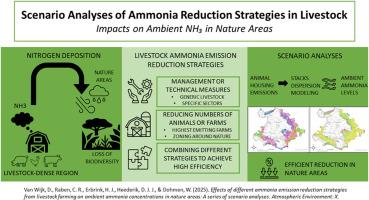畜牧业不同氨减排策略对自然地区环境氨浓度的影响:一系列情景分析
IF 3.4
Q2 ENVIRONMENTAL SCIENCES
引用次数: 0
摘要
过量的氮沉降是自然地区的一个主要问题,造成土壤酸化和富营养化,减少了生物多样性。在荷兰,大部分氮来自与农业有关的氨排放。本研究以家畜密集区附近的自然区域为研究对象,探讨了不同的氨减排策略对家畜相关环境氨水平空间格局的影响。其目的是深入了解干预措施对环境暴露水平的影响和缓解战略的效率。利用弥散模型,考虑到大约4500个农场的排放,估算了每个情景下环境氨水平的年平均模式。结果表明,通过技术或管理修改或农场搬迁实现的氨排放显著减少(54% - 86%)的情景导致自然区域内环境氨水平大幅降低(62% - 87%)。针对对自然地区氨水平贡献最大的特定部门的有针对性的战略实现了相对适度的绝对减少(8 - 13%),但与更通用的方法相比,总体上效率更高。情景效率,定义为排放/浓度减少之间的比率,在0.5到1.3之间变化很大。这种差异强调了评估空间氨格局的重要性,而不是仅仅关注和依赖以总质量表示的排放量减少。减排策略的效率取决于靠近自然区域的(特定行业的)农场的地理分布,以及这些农场的排放高度。因此,明确针对这些因素的联合战略,如将空间重点措施(如分区)与一般减排相结合,预计将最有效地降低自然地区的氨浓度。本文章由计算机程序翻译,如有差异,请以英文原文为准。

Effects of different ammonia emission reduction strategies from livestock farming on ambient ammonia concentrations in nature areas: a series of scenario analyses
Excessive nitrogen deposition is a major problem in nature areas, causing soil acidification and eutrophication, which reduces biodiversity. In the Netherlands, most nitrogen originates from ammonia emissions related to agriculture. This study investigates how various ammonia emission reduction strategies affect spatial patterns of livestock-related ambient ammonia levels, focusing on nature areas near a livestock-dense region. The aim is to provide insights into effects of interventions on environmental exposure levels and efficiency of mitigation strategies. Using dispersion modeling, annual average patterns of ambient ammonia levels were estimated per scenario, considering emissions from approximately 4500 farms. Results indicate that scenarios involving significant reductions in ammonia emissions (54–86 %), achieved through technical or management modifications or farm removal, result in substantial reductions (62–87 %) in ambient ammonia levels within nature areas. Targeted strategies aimed at specific sectors that contribute most to ammonia levels in nature areas achieved relatively modest absolute reductions (8–13 %) but generally higher efficiency compared to more generic approaches. Scenario efficiency, defined as the ratio between emission/concentration reduction, varied considerably from 0.5 to 1.3. This variations underscores the importance of assessing spatial ammonia patterns rather than focusing and relying solely on emission reduction expressed in terms of total mass. The efficiency of reduction strategies depends on the geographical distribution of (sector-specific) farms near nature areas, and emission height from these farms. Therefore, combined strategies explicitly targeting these factors, such as integrating spatially focused measures (e.g., zoning) with generic emission reductions, are expected most effective in reducing ammonia concentrations in nature areas.
求助全文
通过发布文献求助,成功后即可免费获取论文全文。
去求助
来源期刊

Atmospheric Environment: X
Environmental Science-Environmental Science (all)
CiteScore
8.00
自引率
0.00%
发文量
47
审稿时长
12 weeks
 求助内容:
求助内容: 应助结果提醒方式:
应助结果提醒方式:


